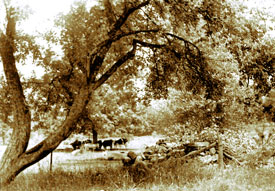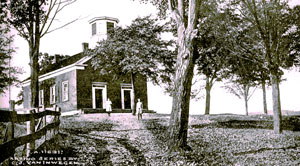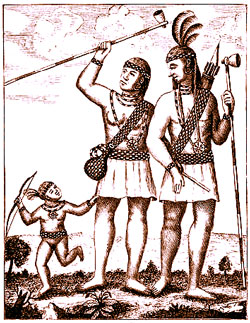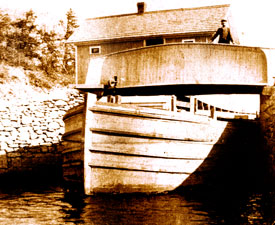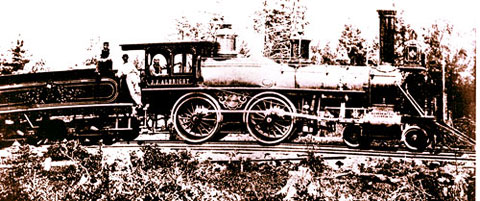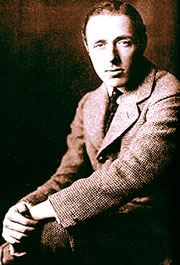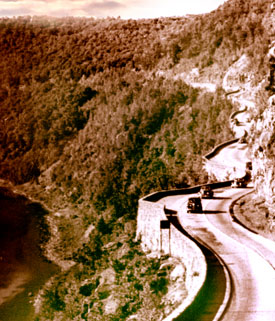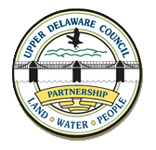History
The Town of Deerpark is a rural town in the southwestern corner of Orange County. It is nestled among lakes, streams, rivers and mountains and is bounded by the Delaware, Neversink, and Mongaup Rivers, the Shawangunk Mountains, and the wetlands of the Basha Kill. Geography has been a major factor in the town’s growth and development.
This land was the frontier of early America. Covered wagons carrying pioneer stock trundled westward from the Hudson River to settle here. A settler named McDaniel enclosed a small tract of land with a fence made of brush. Some of his neighbors called it McDaniel’s “Deerpark”. Soon the entire area was known by that name.
Seven hamlets, Cahoonzie, Cuddebackville, Godeffroy, Huguenot, Rio, Sparrowbush and Westbrookville make up the Town of Deerpark. The origins of theses names reflect the history of the town.
Cahoonzie is located on land where the Cahoonshee Indians lived and where Chief Cahoonzie is buried.
Cuddebackville is named for William Cuddeback, a colonel in the War of 1812 and a descendant of one of the first families.
Godeffroy is named for Adolphus E. Godeffroy, an active participant in the Port Jervis & Monticello Railroad. He built an extensive estate in the area which now bears his name.
Huguenot originally was called “Sindeaquan” by the Lenni Lenape Indians. The earliest settlers called this area “Peenpack”. Later the hamlet was named in honor of the early Huguenot refugees who came here seeking religious freedom.
Rio was known as “Quarry Hill”. Bluestone from local quarries was mined and shipped via the D & H Canal to New York City for its sidewalks. When the town requested a post office, they were notified that there was another town named Quarry Hill in New York. The citizens then decided to name their hamlet Rio in honor of Ben Ryal, a post master who had been instrumental in organizing the post office. Apparently, when his name was spoken, the letter “l” was dropped so that his name sounded like “Rio”.
Sparrowbush originated from Henry L. Sparrow, owner of a large tract of timberland near the D & H Canal. This land had been called Sparrow’s “Bosh”, meaning Sparrow’s slope or Sparrow’s “Bosk” meaning Sparrow’s thicket or woods. Over the years it changed to its present name, Sparrowbush.
Westbrookville was named for Dirck Van Keuren Westbrook, an early settler. Fort Westbrook, dating back to the American Revolution, still stands.
The peaceful Lenni Lenape Indians were the first inhabitants. Chief Penhorn and his tribe inhabited about 780 acres of fine natural meadow land on the east side of the Neversink River. In 1690, William Tietsoort, the first European inhabitant in the valley, was asked to move here by the Lenni Lenape to build a blacksmith shop to make much needed tools.
In 1697, a 1200 acre patent of land was granted to Jacob Codebeck, Thomas Swartwout, Anthony Swartwout, Bernardus Swartwout, Jan Tyse, Peter Germar (Gumaer) and David Jamison. They were sturdy Dutch farming families and lived peacefully with the Lenni Lenape.
With the early rumblings of the French and Indian War,the local residents were asked to form a militia in preparation for the possibility of war. This broke the trust of the Lenni Lenape who subsequently moved west to the Ohio Territory.
Many families traveled along the Old Mine Road, America’s oldest 100 mile road, to settle in this fertile valley watered by pristine rivers. They were not, however, to live in peace. The boundary line between New York and New Jersey was still undetermined. Both states wanted the best farm lands along the disputed boundary line, which at that time cut across the entire town. Residents on both sides fought and kidnaped each other and destroyed each other’s homes and property during “The New Jersey-New York Border War”. Finally, on September 1, 1773, the present boundary line was established by England.
In order to maintain the size of Orange County, five towns from Ulster County were incorporated into Orange. Deerpark was formed from the Town of Mamakating in Ulster County.
On October 13,1778, during the American War of Independence, Colonel Joseph Brant and his raiders approached by way of an old trail from the Mongaup River to Huguenot. The order of attack went from south to north ending at Fort DeWitt in Cuddebackville.
Brant returned again on July 20, 1779 bringing with him twenty-seven Tories and sixty Indians to fight against the settlers. It was this raid which lead to the major battle at Minisink Ford where many local militiamen lost their lives. It also was the source of “The Painted Apron Story” at the Black Rock School, a local folk tale, which has become a part of our history.
When the War of Independence ended, the pioneer spirit took hold again, and some residents left this valley to follow the westward dream. The abandoned land enabled those who remained to enlarge their holdings and build bigger farms and mills.
The construction of the D & H Canal (1828-1898) dramatically changed the Town of Deerpark. Primarily, it was constructed to provide much needed Pennsylvania anthracite coal to New York City. Other goods, such as bluestone, cement and lumber, were shipped as well. The route of the canal through Deepark was determined by the relative ease of construction through this valley. New industries were created and old ones expanded. Quarries, tanneries, lumber mills, boat yards, supply stores, blacksmith shops, carpenter shops were busy places along the canal. Homes were built making schools, churches and public buildings necessary. Many of these buildings remain throughout the town.
The town’s make up changed once again with the advent of the railroad. In 1868, the Monticello & Port Jervis Railroad Company started to bring people here for vacations and to enjoy the natural beauty of the rivers and mountains. A thriving resort industry arose. The railroad also was instrumental in making commercial dairying in the Neversink Valley a viable occupation. Each farm within a convenient distance of a railroad had a “milk stop” to pick up cans of milk to ship to New York City. Since the middle of the 20th century, farming has no longer been profitable.
The automobile brought even more people to the town. Among them was D. W. Griffith. Between 1909 and 1915, he made many films using the majestic mountains and flowing rivers as natural backdrops. The Neversink Valley Area Museum in Cuddebackville regularly shows the classic silent movies.
The recognition of our history is an ongoing part of our community. The Neversink Valley Area Museum has exhibits about life on the D & H Canal, including boat rides on the canal. School children visit the museum to learn about the Lenni Lenape. The town has restored an 1863 brick schoolhouse for community use. Other one room schools have been converted into private homes.
Geography remains an important part of the town’s identity. Camps care for natural areas and teach environmental education courses. The Nature Conservancy has extensive holdings of environmentally fragile sections of the Neversink River. The Orange County Land Trust and the Basherkill State Wildlife Management Area protect sections of the Basha Kill wetlands. The Orange County Parks Department has developed a lovely park to preserve one of the few sections of the D & H Canal which still holds water.
New York State has designated Route 97 and the Hawk’s Nest as a scenic by-way along the Delaware River. The New York State Department of Environmental Conservation has set aside land as an eagle preserve. All of these places give visitors and residents the opportunity to enjoy activities such as fishing, hunting, canoeing, rafting, camping, hiking, and birdwatching.
Reflecting on our past gives us pause to think about our future and how change will continue to be a part of this town. Some changes already are in progress, such as the plans for building an Interpretive Center near the Mongaup River by the National Parks Service and the plans for the creation of a walking/biking trail along the abandoned D & H Canal towpath from Westbrookville to Cuddebackville by the Orange County Parks Department. These plans show how our history effects present day changes.
Written by Norma Schadt
All Images courtesy of Brian J. Lewis’s “Images of America – DEERPARK”
Arcadiapublishing.com
